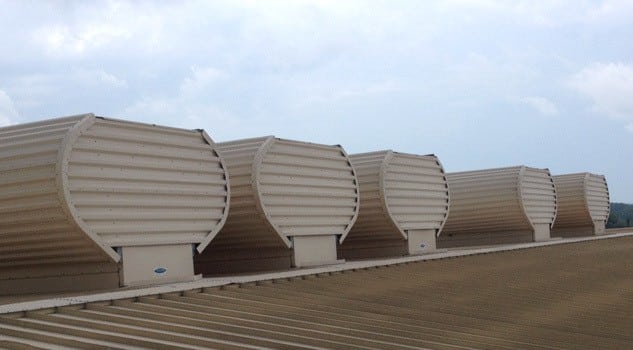The Science Behind Natural Ventilation

Throughout history, buildings have utilized natural ventilation. With the increased push toward energy efficiency, however, the science behind natural ventilation has once again become immensely popular. Depending on the design of the building, the local climate, and the building’s purpose, natural ventilation can be an effective means of keeping the space at a comfortable temperature while reducing energy consumption and maintenance.
When ventilating a building naturally a circuit of air movement is created. This circuit supplies fresh air into the interior space while allowing the existing air to exhaust. This air flow circuit is designed to take advantage of the changes in pressure that occur due to differences in temperature and humidity in the air. Natural airflow into, out of, and within the building is manipulated through the strategically placed entrance and exhaust vents. This promotes better air movement throughout the space. Concisely, this is the science behind natural ventilation.
How Natural Ventilation Increases Air Movement and Controls Temperature
The warm air inside of a building has a lower density than the cool air outside. This difference causes the warm air within the building to naturally rise to the ceiling. A natural ventilation system often referred to as a Gravity Ventilation system, makes this air movement easier by removing the biggest obstacle in its path, the ceiling. Ventilators go on the roof of the building to allow large volumes of warm air to escape. These ventilators allow the maximum amount of air to evacuate the building while still prohibiting rain, animals, or debris from entering.
As the temperature outside the structure rises and falls, the natural ventilation system is easily able to control the interior temperature by allowing air to exhaust as needed. Increases in the speed of incoming supply air through the wall, or a strong breeze over the top of the ventilator, will often lead to an increase in the rate of air movement in the building.
The self-adjusting nature of a natural ventilation system, along with its ability to cool more effectively in ridiculously hot conditions, and the money and energy savings benefits, have led to the increase of its use.
Science in Action!
First, it is important to understand the science of a natural ventilation system. A naturally ventilated building is a very delicate and intricate process. A ventilation engineer must consider several factors when designing a new ventilation system.
Every opening within a building will affect the internal airflow, and in turn, the interior temperature. Intake and exhaust vents, as well as doors, windows, loading docks and bays all, affect the air movement within a building. Additionally, there are also internal factors such as walls, barriers, the placement of large equipment, solar heat loads, and more.
The ability to establish an effective natural ventilation system is also reliant on a building’s surrounding environment. Each individual facility will have factors unique to its location. A ventilation engineer will consider these factors when designing the system. Factors such as average monthly temperatures, weather patterns, and more will all make a difference when designing a natural ventilation system.
The location of the actual structure itself is also important when designing for natural ventilation. The orientation of the building can make an enormous difference when the temperature increases in the afternoon. Taking advantage of the natural cooler and warmer parts of the day can increase the effectiveness of a natural ventilation system.
The Science Behind Natural Ventilation
As there are so many factors to consider when designing a natural ventilation system, expertise goes a long way. Knowing how each piece of the puzzle fits together is crucial to developing a system that functions properly. A poorly designed natural ventilation system can make the facility even hotter. This is because the warm air may be trapped in the walls. Additionally, the system could inadvertently push the warm air back down to the work floor. Therefore, it’s so important to have someone that knows the science behind natural ventilation designing the system.
Just as choosing the right equipment is important, selecting a design that properly controls the flow or air is vital to making an effective and efficient natural ventilation system. Natural ventilation is most successful in high-bay structures, such as warehouses, heavy industrial plants, and factories. It also works very well in facilities in warmer climates and ones with a lot of heat results. Learn the science behind natural ventilation to take the first step to a better system today.
